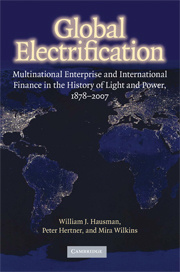 Global Electrification
Global Electrification Book contents
- Frontmatter
- Contents
- Tables and Illustrations
- Series Editors' Preface
- Preface
- Acknowledgments
- Authors and Contributors
- PART I CONCEPTS
- PART II CHANGES
- PART III CONCLUSIONS
- Appendix A: Abbreviations, Acronyms, Company Names, and Variations on Company Names
- Appendix B: Notes to Table 1.4 Foreign Ownership of Electric Utilities, Four Periods
- Notes
- Select Bibliography
- Index
Series Editors' Preface
Published online by Cambridge University Press: 26 July 2009
- Frontmatter
- Contents
- Tables and Illustrations
- Series Editors' Preface
- Preface
- Acknowledgments
- Authors and Contributors
- PART I CONCEPTS
- PART II CHANGES
- PART III CONCLUSIONS
- Appendix A: Abbreviations, Acronyms, Company Names, and Variations on Company Names
- Appendix B: Notes to Table 1.4 Foreign Ownership of Electric Utilities, Four Periods
- Notes
- Select Bibliography
- Index
Summary
The availability of electricity is largely taken for granted in industrialized countries, and yet as the authors of this path-breaking study emphasize, the dissemination of electric power over the last century was a massive endeavor. The distribution of electricity was, the authors show, a global project. We see the enormous importance of global firms, in a wide variety of corporate forms, in electrification before 1914 and after; yet at the same time, a countervailing force mounted, that is, the reduction of the role of these global firms, as governments assumed the responsibility for providing electricity; and then the reemergence in the contemporary era of global businesses as major forces in the world industry. In this and other regards, the spread of electric utilities tells us much about the larger patterns of evolution of the world economy through the vast changes that have occurred as countries industrialized and then moved into the information age. The authors have done research in historical archives located all over the world and in dozens of languages. They have demonstrated a mastery of many different historical literatures. The book points to a new style of “global business history” where the linkages between national experiences are mapped out to become a central explanatory theme, and where national experiences are compared and contrasted rigorously. In short, the authors have created the ultimate work of reference on the electrification of our world.
- Type
- Chapter
- Information
- Global ElectrificationMultinational Enterprise and International Finance in the History of Light and Power, 1878–2007, pp. xi - xiiPublisher: Cambridge University PressPrint publication year: 2008
